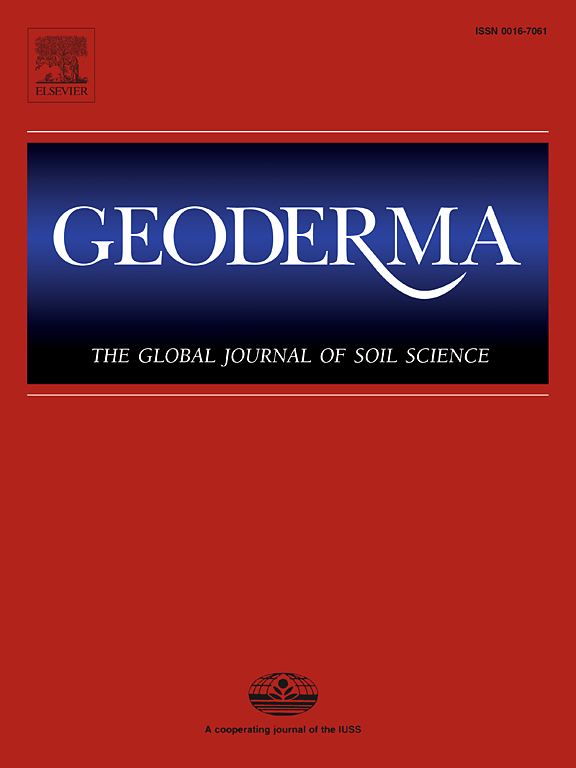Low-quality straw over high-quality straw preferred for mineral-associated organic matter formation
IF 5.6
1区 农林科学
Q1 SOIL SCIENCE
引用次数: 0
Abstract
The formation of mineral-associated organic matter (MAOM) from plant litter decomposition is crucial for climate change mitigation. However, the way in which plant litter of varying qualities influences MAOM formation and decomposition, particularly regarding the quantity of litter inputs, remains largely unclear. This study aimed to determine how the quality of straw, specifically low-quality wheat (Triticum aestivum L.) versus high-quality milk vetch (Astragalus sinicus L.), and its quantity (input level) affect MAOM formation and decomposition. We conducted a 420-day laboratory incubation experiment using low-quality wheat versus high-quality milk vetch straws added to artificial soil (pure quartz vs. soil with reactive minerals (sandy soil: 5 % clay, 10 % silt, and 85 % sand)) at input levels of 0, 3, 6, 18, 26, 31, and 35 g C kg−1 soil. Different from the Microbial Efficiency-Matrix Stabilization theory, our research indicates that adding low-quality wheat straw led to significantly greater MAOM content than high-quality milk vetch. Notably, the MAOM stabilization efficiency declined at high input levels (26, 31, and 35 g C kg−1 soil) for wheat than for milk vetch. This is further supported by the evidence that reactive minerals slowed the decomposition rate of low-quality wheat straw more effectively than that of high-quality milk vetch. Moreover, the lower C/N ratio of the MAOM fraction, the reduced C/N ratio of dissolved organic matter (DOM), and a higher fluorescence index of DOM (higher values indicating greater contribution of microbial sources) after adding milk vetch than adding wheat straw suggest the significant role of plant-derived organic matter in MAOM formation. Our findings disclose that reactive minerals preferentially protect low-quality litter over high-quality litter through direct interaction with plant-derived organic matter, providing a critical pathway for MAOM formation distinct from microbial assimilation. This study highlights the key role of low-quality straw in the efficient and long-term stabilization of soil C within agricultural practices.
低质量秸秆优于高质量秸秆,有利于矿物伴生有机质的形成
从植物凋落物分解中形成矿物相关有机质(MAOM)对减缓气候变化至关重要。然而,不同质量的植物凋落物对MAOM形成和分解的影响方式,特别是凋落物输入的数量,在很大程度上仍然不清楚。本研究旨在确定秸秆质量,特别是劣质小麦(Triticum aestivum L.)和优质黄芪(Astragalus sinicus L.)及其数量(输入水平)如何影响MAOM的形成和分解。我们进行了一项为期420天的实验室孵化实验,将劣质小麦秸秆与优质豇豆秸秆分别添加到人工土壤中(纯石英与含有活性矿物质的土壤(砂质土壤:5%粘土、10%淤泥和85%沙子)),输入水平为0、3、6、18、26、31和35 g C kg - 1土壤。与微生物效率-基质稳定理论不同,我们的研究表明,添加劣质麦秸导致MAOM含量显著高于优质豇豆。值得注意的是,在高投入水平(26、31和35 g C kg - 1土壤)下,小麦的MAOM稳定效率比豇豆低。活性矿物对低品质麦秸的分解速率比对优质豇豆的分解速率更有效,这也进一步证明了这一点。此外,与添加麦秸相比,添加豇豆后MAOM组分的C/N比更低,溶解有机质(DOM)的C/N比更低,DOM的荧光指数更高(数值越高表明微生物源的贡献越大),表明植物源有机质在MAOM的形成中发挥了重要作用。我们的研究结果表明,活性矿物质通过与植物源有机质的直接相互作用,优先保护低质量凋落物而不是高质量凋落物,为MAOM的形成提供了一个不同于微生物同化的关键途径。本研究强调了低质量秸秆在农业实践中有效和长期稳定土壤C的关键作用。
本文章由计算机程序翻译,如有差异,请以英文原文为准。
求助全文
约1分钟内获得全文
求助全文
来源期刊

Geoderma
农林科学-土壤科学
CiteScore
11.80
自引率
6.60%
发文量
597
审稿时长
58 days
期刊介绍:
Geoderma - the global journal of soil science - welcomes authors, readers and soil research from all parts of the world, encourages worldwide soil studies, and embraces all aspects of soil science and its associated pedagogy. The journal particularly welcomes interdisciplinary work focusing on dynamic soil processes and functions across space and time.
 求助内容:
求助内容: 应助结果提醒方式:
应助结果提醒方式:


